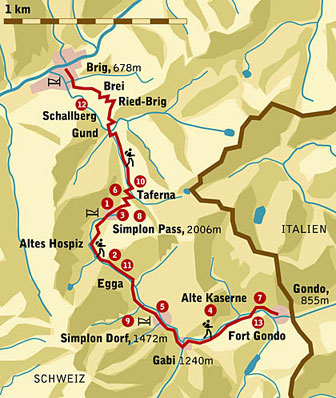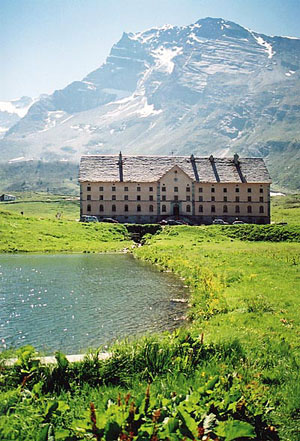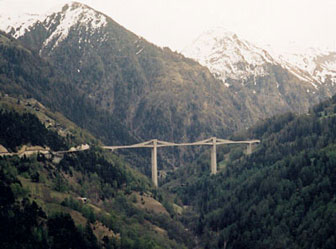Der Simplon
|
Both have
left there legacies: Stockalper with his buildings along the way, an example
shown is the Stockalerpalast in Brig.
Also, the way that Stockalper used then has been reconstructed and is
now used as a tramping path. From the
Napoleonstrasse pretty much only the line taken remains. The road built for traffic follows to a large
extent that put in place by Napoleons engineers. 1. Die Römerstraße We see: Der Simplon had, at different times, an enormous international meaning. Different phases of the “economic situation” and “recession” of the alpine pass can be shown through the history of Der Simplon. Humans crossed the alps through Der Simplon almost always. Earlier finds point to a possible use in prehistoric times; likewise there are indications of Roman traffic activity. Medieval history is to a large extent unknown; however the historically occupied international meaning lies between the 13th and the 15th centuries. |  |
"Der Simplon" was the shortest connection between the Champagne fairs in Northern France and the Upper-Italian commercial centres, in particular Milan. In the 16th century, the Eschentaler wars as well as confusion relating to political affairs in Wallis led to the end of the Säumer traffic over the Simplon.
 |
2. Die Via Stockapler After more than a century of unimportance a new phase of trade began over the pass, thanks to Kasper Jodok Stockalper (1609-1691). Stockalper achieved his economic success at a time in which the whole of Wallis was experiencing an economic boom and also gained status of international political importance. Stockapler used this international accompaniment (30 year war, enmity between France and Spain) to its full extent. He had a monopoly on salt and lots of real estate in Wallis and through this he became very wealthy. Besides this, he also occupied an important post in the Republic of Wallis. He reorganised traffic over the pass, built monumental buildings (the Stockalperpalast in Brig, das alte Spittal, den Stockalperturm in Gondon) and he had up to 200 Säumer in his service. Due to his authority he was also referred to as “Roi du Simplon”. (The Saum path used by him over the Simplon was reconstructed a few years ago and can be walked as the “Stockalperweg”. More on that later.) 3. Die Napoleonstrasse After a high, a low has to follow: After Stockalpers loss of power and then his death the pass once again lost its meaning. That is, until the next important man stepped into the History of this pass, Napoleon. Whereas with Stockalper, economics were the centre of attention, then Napoleon setup the military importance of the alpine pass. He recognised that the Simplon was the shortest connecting route between Paris and Milan and wanted to use this for his expansion plans. In September of 1800 he gave the instruction to build; the road was established between 1801 and 1805. In charge of this project was the street building engineer Nicolas Céard and despite all the problems with the engineers under him, the disputes between the Italian and French workers and the topography of the Gondoschluct, he was able to complete his work and it was opened on the 9th October 1805. |
However, this was too late for Napoleon who had to use the Mont Cénis for his return from his coronation as King of Italy. After the end of Napoleons realm Wallis took over this road. It was seen at that time as a technical wonder work with its bridges, galleries and with a width of at least 7.2 metres: in economic terms it now gained tourist importance. In the 19th century competition grew in the Simplon pass with the building of new pass roads, alone, in front of the Gotthardpass. But much larger competition came in due course, the Gotthardtunnel and especially the Simplontunnel. On the 1st July 1906, the first train drove through the Simplon; in succession to this the traffic over the pass nearly came to a stand still. But with the rise of the automobiles of that age this changed once again and nowadays, owing to a newly developed road, the Simplon is a popular transition route for large and small cars, to the occasional disappointment of cyclists.
|
4. Die Nationalstrasse In the year 1958 the building of the Nationalstrasse in Simplon began and like Napoleons engineer Ceard had envisioned (but not built) the new road swings in an elegant elbow through the cliffs of Brierbergs after the Schallberg, here we meet the parade piece of the road: the Ganterbrücke and a light S cross the Ganterbach at a height of 100 metres. The road was inaugurated in 1975 but work still goes on today. Here you can find detailed Literature on this topic. Sources: http://www.montivagus.de/chpsim.html#bild1 (9. 5. 06) |  |
5. Der Tunnel
2006: Hundert Jahre Simplontunnel
The 1898-1905 and 1912-1921 built Simplon-Basis Tunnel between Italy and Switzerland, at a length of 19.82km, was the longest mountain tunnel on earth. On the 19th May 1906 the railway tunnel was officially opened. The second tube was finished in 1921. The tunnel became particularly well known, as up till 1977, the Simplon-Orient-Express ran through it.








